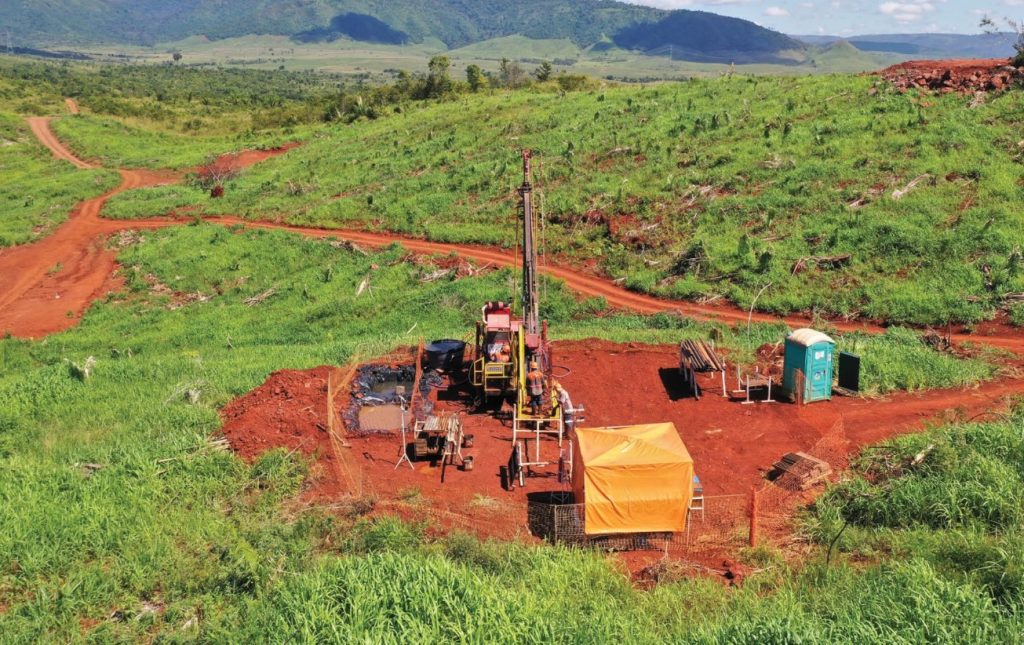Bravo Mining drills 9.48% copper, 2.1 g/t gold over 8.75 metres at Luanga, Brazil

Bravo Mining Corp. [TSXV-BRVO; OTCQX-BRVMF] has received assay results from the second drill hole at the T5 target and from the first drill hole in the T16 electromagnetic target at the Luanga Project, Brazil.
This is the third HeliTEM (Helicopter based electromagnetics) target to be drilled at the 100%-owned Luanga Project which includes the Luanga palladium + platinum + rhodium + gold + nickel deposit in the Carajas Mineral Province, state of Para, Brazil.
“Exploration continues to yield very encouraging results, both from ongoing drilling at T5, and now at another HeliTEM geophysical target, T16. At T5, we continue to intersect high-grade Iron Oxide Copper Gold style (IOCG-style) mineralization, which is a well-documented style of mineralization in the Carajas, while at T6 and now T16, we potentially see two distinctly different styles of mineralization that appear magmatic related,” said Luis Azevedo, Chairman and CEO.
“Whilst we are encouraged with these discoveries, we are still in the early days of the exploration program and these initial successes suggest potential for yet more discoveries given the number of anomalies Bravo has yet to test or follow up.” he said. “We also need to integrate these findings and new styles of mineralization into our regional models to reassess all the other HeliTEM anomalies that were previously set aside before we encountered IOCG-style mineralization at T5. The Carajas Mineral Province is an exceptionally fertile area and Luanga sits within a corridor containing several significant IOCG deposits/operations. Bravo looks forward to continuing our exploration efforts in this prolific region.”
Highlights: Hole DDH2405T004 at Target T5, located 50m east and along strike of previously reported high-grade hole DDH2405T002, intersected 8.75m of massive/semi-massive/breccia hosted high-grade copper sulphide mineralization grading 9.5% Cu and 2.1g/t Au.
High-grade copper-gold mineralization at Target T5 remains open at depth and along strike. Hole DH2405T006 is now in progress at T5, below (down-dip of) discovery hole DH2405T002.
Initial drill hole DDH2416T001 at Target T16 HeliTEM target intersected 1.29m of breccia hosted sulphide copper-nickel mineralization grading 2.39% Cu, 1.17% Ni. Mineralization at T16 is potentially a different style of mineralization, one not previously observed at Luanga.
Drilling will continue at T5, while a second drill rig will commence follow-up drilling on BHEM (Borehole Electromagnetic) anomalies at T6, T11, T15, T16 and T17.
As a result of the initial positive results, the EM-target drilling has increased from an initial 3,000m to 8,000m and may increase further, depending on results.
Bravo continues to conduct systematic first-pass drilling, coupled with BHEM, on the priority EM conductors identified by the HeliTEM survey. Although these modelled HeliTEM conductors have a lower degree of locational accuracy, they are sufficiently defined to position first-pass drilling proximal to the conductor’s location. From there, BHEM provides more precise location of EM anomalies for drill testing. Of the 17 priority EM anomalies identified in the HeliTEM survey, Bravo has narrowed this list to 11 high priority conductors that warrant follow-up drilling of predominantly off-hole BHEM conductors. T5, T6 and now T16 are three of these 11 HeliTEM targets.
Drilling will continue at T5, while a second drill rig will commence to follow-up drilling on BHEM anomalies at T6, T11, T15, T16 and T17, before moving to new targets to implement initial drilling/BHEM.
T16 is located 1km south of the PGM+Au+Ni mineralization in the Central Sector and is hosted in meta-diorite below the Luanga footwall ultramafic sequence. The intersected mineralization consists of 1.3m of breccia hosted sulphides, mainly pyrrhotite, generating a strong EM response. This first drill hole at T16 targets the HeliTEM anomaly and appears to have successfully intersected the EM conductor. BHEM data indicates that the conductor extends at depth, below DDH2416T001.
T16 has a clear association between Ni-Cu and Pt-Pd-Au, which is very different to both T5, which is essentially chalcopyrite (Cu sulphide) associated, and T6, which is essentially pyrrhotite (Fe sulphide) associated.
Follow-up drilling will target the BHEM conductor at a greater depth, below DDH2416T001.
A total of 298 drill holes have been completed to date by Bravo, for 63,672 metres, including 8 metallurgical holes (not subject to routine assaying). Results have been reported for 249 Bravo drill holes to date. Assay results for 41 Bravo drill holes that have been completed are currently outstanding (excluding the metallurgical holes). Bravo plans to extend the current EM drilling program from 3,000m to 8,000m, to follow up identified EM anomalies, continue to systematically evaluate T5, and other high-priority conductors defined by HeliTEM and subsequent BHEM surveys. In addition to exploratory drilling on EM anomalies, ongoing drilling continues at the Luanga Deposit.
The Luanga Project is situated on mature freehold farming land and benefits from being in a location close to operating mines and a mining-experienced workforce, with excellent access and proximity to existing infrastructure, including road, rail, and clean renewable hydro grid power. A fully funded 63,000-metre infill, step-out and exploration drilling and trenching program is well advanced for 2024. Bravo’s current Environmental, Social and Governance activities include planting more than 18,000 high-value trees in the project area, hiring and contracting locally, and ensuring protection of the environment during its exploration activities.
